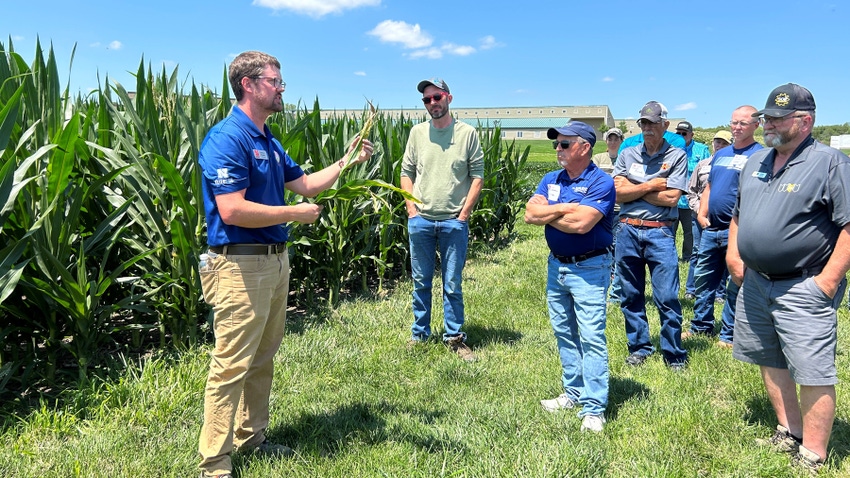
Right source, right rate, right time and right place. These 4R’s can be hard to manage correctly, but it is crucial to do to improve yields and profits.
On July 6, experts in nutrient management came together to further educate producers and consultants at the University of Nebraska Eastern Research, Extension and Education Center near Mead. The 4R’s management field day taught attendees best practices on how to manage nitrogen, phosphorus and potassium — along with sharing results from studies conducted from UNL and Iowa State University.
Fertigating with nitrogen
The timing of nitrogen applications to match crop need is essential to practice good management. Rapid nitrogen uptake starts at the V10 to V12 stage. One management strategy that will allow producers that irrigate to easily apply nitrogen is through fertigation.
Joe Luck, a UNL professor of biological systems engineering, works with On-Farm Research to test fertigation on Nebraska farms. Working hand in hand with sensor technology, the producer can tell if they can wait a week to apply nitrogen. A week might not seem like a big deal, but being able to apply when the corn is between V10 and V12 can allow for a higher percentage of uptake and less runoff.
Sensor technology has developed over the years. “To go through this process manually, it would take about six hours to deliver the decision based on data,” Luck says. “Now it takes three minutes.”
Because of technology advancements, within minutes there is a nitrogen prescription that can be delivered to the field.
Strategizing with phosphorus
“Naturally there are 200 to 300 pounds of phosphorus available in the soil, but not all readily available to plants,” says Swetabh Patel, a postdoctorate research associate at UNL.
When there is a phosphorus deficiency in the field, Patel recommends three different practices that will lead to best management, depending on the operation’s goals.
First, there is deficiency correction. This is intended to optimize profit. The risk is that in some years or locations, nutrient supply may limit the yield.
The next management practice that is recommended is crop removal. “This approach is based on the idea of applying phosphorus that was removed by the previous year’s crop,” Patel says. Depending on your soil type, you might need more or less phosphorus.
The last strategy is maintenance and build. This is intended to minimize potential for nutrient limitations to yield. The risk that is associated with this strategy is that in most years, no yield increase will happen with a phosphorus application. This will reduce profits.
The frustrating nutrient
When it comes to testing soil for potassium, there is more uncertainty, and predicting crop response becomes a challenge. A lot of the issues revolve around how much moisture is in the soil and the complex reactions of the ions.
Antonio Malarino, professor of soil fertility and nutrient management at ISU, has found through soil tests that there needs to be a calibrated soil test for each cation to truly recognize how much of that ion is in the soil.
“We have found that this so-called nonexchangeable potassium actually is available that we are not measuring,” Malarino says. By calibrating the test to the specific ion, more accurate measures of nutrients in the soil can be found.
“September is when the soybeans start to yellow in Iowa,” Malarino says. “And essentially after November and December there is not much [potassium] left. The soil leached out anywhere from 80 to 100 pounds of potassium.” When looking at yields over time, see if there is any profitability of adding more potassium to the field.
Managing nitrogen, phosphorus and potassium can be a challenge. But focusing in on the right source, right rate, right time and right place can help producers be better stewards of the environment and improve the bottom line.
Tips and tricks to nutrient management
Do you live on the border of your state? Check out surrounding Extension materials to make sure you have the best information based on your area.
It depends. This phrase is thrown around a lot because fields vary from one place to another. When coming to Extension specialists with a problem, come prepared. It is important to know the field history, goals of the operation and if you own or rent the land.
Look at research. There is research that happens at UNL and other land-grant universities across the Midwest. At the end of the day, it is important to consider if the input will bring a reasonable return.
About the Author(s)
You May Also Like






